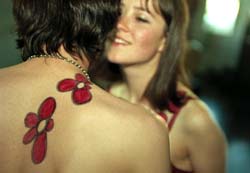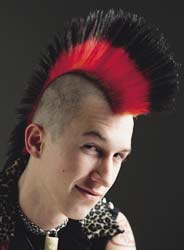|
Sex and sexuality are central to our being and socio-biologists
are keen to emphasise the role they play in determining every day
actions. But the result of our sexual origins is that we are bound
into an intricate web of personal and social relationships.
by Pete Moore
Ever since giggling over rabbits in
school biology lessons, we knew where we came from. There was the
Daddy that bought the sperm and the Mummy that supplied the egg
– and, at least in the case of mammals, a place for it to
grow. But take a moment to think about it. Once we step out of the
classroom into real life, our parents donate much more. They come
with families of their own - a pedigree that stretches back further
than records can tell.
Most of us take this
for granted and think of it only occasionally. We see our grandparents
from time-to-time, and a few of us are lucky to meet our great grandparents.
And we know their stories. We are told what they did in the war,
about the time they spent in far-flung countries; we might even
hear of the time that a wayward uncle spent in jail.
The stories become
part of our own identity. The family as it emerges in the way its
history is retold infiltrates our very being, which is why it can
be so painful to discover that the family you had always believed
you had, was in fact fake.
This happened to Christine
Whipp, a woman born in the south west of England in 1955. She was
brought up believing the person she called ‘Dad’ was
her father, only to discover just after she was 40 that her true
Dad had been an anonymous sperm donor. She’d always suspected
that there was something wrong with the family. After all how come
she had blond hair instead of her ‘father’s’ genetically
dominant dark hair. Her sense of who she was didn’t map with
the story she was told. In Christine’s case the act of sex
that initiated her arrival in the world had been disjointed, impersonal
and occurred in a doctors consulting room, but it was still intrinsic
to her being.

Courtesy of Digit 52 - Alamy Images
Ssssh...Keep
it quiet...You are turning into your parents!
|
The issue is now more
than one of simple scientific curiosity, but is now pawed over by
lawyers and politicians alike. A case crawling little faster than
a snail through the English high court is challenging the law that
guarantees anonymity to adults who donate sperm or eggs. It’s
difficult to see how this law can stand. Your genetic heritage and
the family you are therefore linked to is a part of a person, so
deliberately withholding that information must infringe the person’s
rights and therefore stand contrary to European human rights legislation.
Genetic
Back to our biology
class and we remember that sex passes on genes. One question has
been chased around for decades. To what extent do these genes, which
have been so strangely selected and sorted through generations of
family history, install a personality within us, or do they simply
create a biological machine that is then shaped by events and environment?

Reproduced with permission of Wileys
Ann Jeremiah
and Judy Tabbott
|
The now classic way
of looking at this is to study identical twins who have been separated
at birth. Ann Jeremiah and Judy Tabbott are two such people. They
were born in 1946, into a large working class family in South Wales,
and Ann immediately found herself moved to live with distant middle-class
relatives. While the two girls were hardly even aware of each other’s
existence, some aspects of their lives had striking similarities.
Both were married and pregnant when they were 16, and both found
themselves living with violent partners. But the way they responded
to the situation was different. Middle class, educated Ann, had
the power to walk out and start a new life. Judy had no education,
and therefore no options. She stayed in the marriage for 17 years.
The first time the
two spent any serious amount of time in each other’s company
was when, aged 48, they went to Minnesota to join in with the world’s
largest twins study. It was here that they discovered how similar
many of their mannerisms, motivations and hobbies were.
The genes stationed
in the day one embryo that subsequently split into two people have
left an indelible mark on much more than just their physical appearance.
That said, they are quite clearly two very different and distinct
people who have been individually shaped by their challenges, successes,
disappointments and triumphs. Their genetic endowment is an important
part of who they are, but just one part of their complex beings.
Historic

Reproduced with permission of Wileys
David
Barker pulls a book from the set of data held in the Hertfordshire
archives in 1986 - data that would change his life, and
make us realise that heart disease starts in our history
|
Sex might bring our
parent’s sets of genes together, but that is not the start
of the conundrum – the complexity starts earlier. The puzzling
question of who I am, of what it is to be the human being called
‘me’ seems to start decades before. When in the 1980s
epidemiologist David Barker was trying to make sense of patterns
of heart disease around the country, he hit upon an idea that was
so outrageous it was laughed out of court at first, but with almost
two decades of increasingly well-funded research to support him,
he is beginning to convince others.
One of the more remarkable
aspects of his theory, sometimes referred to as the Barker Hypothesis,
is that your chance of having heart disease or diabetes when you
are middle-aged is highly influenced by the diet your mother’s
mother ate while your mother was in her womb. And the rationale
that is developing is that by the time that a female fetus is just
a few months old, her ovaries contain all the eggs that will ever
develop. Okay they need to mature, but they are there. Not only
are the primitive eggs present, but Barker now believes they are
sensing the nutritional environment. If the mother’s diet
is poor then they will respond and influence the genes they are
carrying in a way that the offspring of those eggs will have the
best chance of surviving in this impoverished place.
The problem then comes
when the offspring are born some twenty, thirty or forty years later,
into a nutritionally rich environment. They weren’t prepared
for such riches, and readily succumb to heart disease. In the quest
to make sense of who we are, as part of the discovery of what it
is to be the human called me, we find ourselves having to look back
to find the human who was my grandmother.
Social

John Donne
|
This intergenerational
thinking is strange to Western societies that have taught themselves
to value individualism, and have started to believe that we can
live in a way that almost denies John Donne’s famous comment
in the 17th century that “no man is an island, entire of itself”.
It is not so strange,
however, to the peoples of Africa who for generations have lived
by a notion that they refer to as Ubuntu. The word has no direct
translation into English, because the concept has no immediate counterpart
in Western thinking. But the gist of the idea can be summed up in
the phrase, “you are a person through other people”
- it is as you take responsibility for other people, and respond
to those around, that you find your own identity. Living in isolation
is not living at all.
For Nobel Peace prize-winner,
Desmond Tutu, this interrelationship is a way of life, because a
self-sufficient human being is subhuman. “I have gifts that
you do not have, so, consequently, I am unique - you have gifts
that I do not have, so you are unique. God has made us so that we
will need each other. We are made for a delicate network of interdependence.
We see it on a macro level. Not even the most powerful nations in
the world can be self-sufficient,” he claims.
And the notion of community
does not just rest with those living and breathing. In African thought
it extends to those ancestors who came before you and goes on to
those who will follow. In this, you, the living individual human
being, are part of a multi-dimensional lattice of relationships,
some of them linked though acts of sexual union, others through
a knowledge that you are part of the same community. “Ubuntu,”
says theologian Michael Battle, “refers to the person who
is welcoming, who is hospitable, who is warm and generous, who is
affirming of others, who does not feel threatened that others are
able and good for [this person], has a proper self-assurance that
comes from knowing they belong in a greater whole, and known that
they are diminished when another is humiliated, is diminished, is
tortured, is oppressed, is treated as if they were less than who
they are. What a wonderful world it can be, it will be, when we
know that our destinies are locked inextricably into one another’s.”
Spiritual

Courtesy of Digit 52 - Alamy Images
"Get
Spiritual Man!"
|
Recognising that there
are aspects of our life and existence that reach beyond pure physical
explanation, that seeks to see why relationships are so important,
that looks for ways of empathising with others’ feelings,
points us towards the spiritual nature of humanity.
You could see the relationship
between a person’s spirituality and their religious outlook
as analogous to the relationship between a person’s sexuality
and their sexual activity. Sexuality influences many different aspects
of a person’s life and the way that he or she relates to other
people, only one of which is their pattern for sexual activity.
People’s sexuality is part of the way they are made and also
reflects the way they are shaped by their upbringing, but the way
that they express that part of their being in sexual intercourse
is strongly influenced by moral values, religious teaching and legal
rulings of the society they live in. Sexual activity is often the
issue that becomes debated endlessly because it is the most obvious
outward revelation of a person’s sexuality, but to limit the
discussion of sexuality to sex would miss the full extent of the
issue.
In terms of spirituality,
could you say that a person’s religious behaviour was the
tip of the spiritual iceberg? If so, it would be a mistake to say
that the tip was all there was, equally it would be a mistake for
religiously minded people to forget the mass of spiritual existence
that supports their faith.
“On the project
of what it is to think of oneself as fully human, to be fully human,
I think the spiritual dimension is enormously important, but very
difficult to pin down,” says moral philosopher Mary Warnock.
“My general definition of the spiritual dimension of a persons
life? It is what really exercises a person’s imagination,
it would embrace the aesthetic.”
She believes that it
is the spiritual facet of human beings that allow them to see beauty
in an arrangement of coloured blobs of paint on a canvas, and to
be emotionally moved by an operatic performance - to see the true
likeness in a portrait, or feel pain and excitement in music.
The first person to
put forward a biological view of spirituality was zoologist Alister
Hardy. In 1965, shortly after he retired from the Chair of Zoology
at Oxford University, Hardy gave the Gifford Lectures at the University
of Aberdeen. As a committed Darwinist, he proposed that religious
experience, or spiritual awareness, has evolved through the process
of natural selection because it has survival value to the individual.
Hardy was suggesting that this form of awareness is potentially
present in all human beings and has a positive function in enabling
individuals to survive in their natural environment. He provided
an evolutionary mechanism to explain the biological mode in which
spiritual awareness emerged in the human species.
The
Challenge

Courtesy of Digit 52 - Alamy Images
Above
all... Be Yourself
|
Sex undoubtedly creates
unique individuals. The sexuality that flows from this shapes our
activities, and is a critical element in forming who we are. It
also has a powerful influence over the way we share our existence
with others.
The challenge for anyone
wanting a holistic view of humanity is to assemble many disparate
facets of our being and fashion them into a single entity. It’s
easy to place a prism in front of a beam of light and split it into
its constituent colours, but less easy to reverse the process. Similarly
it is a relativly easy task to look at any one of the many facets
of human existence and scrutinise it in isolation, but the challenge
then is to recombine them in a way that honours each element, but
also celebrates the apparent simplicity with which most people live
out their lives.
Any process of analysis
that spends too long concentrating on a single aspect, such as our
genetics, history, physique or nurturing environment, at the exclusion
of the others will never describe a full human being. It is the
task of integrating many elements that will drive our understanding
forwards. The failure to take on this task runs the risk of reducing
the value we place on human life and lessening the excitement we
have when we contemplate what it is to ‘be me’.
|
